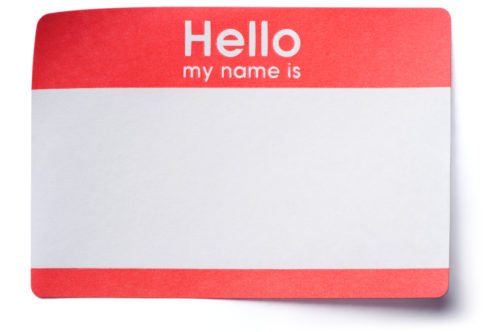
Another school year is upon us, and the campus is replete with human bodies. It is time for newfangled involvements, intellectual discourse, and social encounters. Acquaintances will be contrived, some of which form into lifelong companionship. One of the initial steps to a flourishing friendship includes the typical greeting- “Hi, what’s your name,” “My name is [insert name here],” “What’s yours?” Then continues small-talk, gradually evolving into meaningful conversation as life stories are poked at, unraveled, and digested. Human connection is beautiful, but one must remember not to dampen that burgeoning fire by committing the greatest sin of all friendships: forgetting a name.
We have all done it before. Amidst encountering faces that remind you of past friends, juggling 10 different Nicks, and formulating your next witty response, remembering every new acquaintance’s name is difficult.
But relinquish the fears because potential appellation predicaments can be prevented with simple techniques. As long as you practice these strategies religiously for everyone you meet, your friend retention rate will be optimized and all these human bodies will no longer be just clothed fleshly bipeds, but rather real people.
*Note: New friend is assumed to be male in order to maintain grammatical congruity. No one wants to write “his/her” in every sentence. The author fully supports feminine rights, equality and girl power.
1. Allow new friend to regurgitate his name at least three times, even if the name is facile like “Sammy” or “Bob.” Hearing the name through his voice, and observing the face from which the voice originates combines both auditory and visual memory. In other words, you have now increased the likelihood of remembering that the gentlemen with an interesting mole, full lips, and a nasally voice is called Roberto.
2. Friend him on Facebook, and then peruse his profile. Seeing his full name adjacent to a face and/or body, accompanied by personal information such as date of birth and hometown will strengthen your brain’s synaptic pathways.
3. Fabricate flashcards. The best way to utilize flashcards is by adding new friend’s name on one side, and a photo of his face on the other. The most beneficial photos are unique, exemplifying distinct character traits. How to find said photo you ask? Why undoubtedly through his Facebook, because at this phase you have already stalked browsed his photo albums.
4. If you forget his appellation, do not anguish. Just acquaint him with another friend. But let him do the talking. The dialogue usually ends up like this:
You: Beckoning new friend to meet Sam. “This is Sam- he was in my math class last year.”
Sam: “Hello, how do you do. What is your name?”
New Friend: “Hi Sam, I’m Roberto.”
You: Smile and nod enthusiastically, pleased with the outcome.
And there you go. His name was Roberto. Feeling anxiety is natural when attempting an antic like the above prototype. Fortuitously, the anxiety is facilitating because the person and associating name now elicits a strong emotion. According to the flashbulb effect, strong emotions promote long-term memory. The next two tips will not only ensure that you memorize new friend’s name, but also that new friend remembers YOUR NAME. Friendships are reciprocal. If the companionship becomes one-sided, new friend’s name does not deserve to be remembered. You should then proceed to scavenge the campus for a replacement.
5. Write new friend’s name on a sticky note, and gently place it on his back. Unless his neck is uncommonly flexible, he will not notice the new addition to his outfit. With this sticky note method, you and his other friends will be constantly reminded of his name throughout the day. Then, utilizing the same concept, stick your name onto yourself. The recommended areas are the forehead, neck, and chest, depending on personal preference.
6. When new friend is unaware, steal his prox and replace it with your own. Most students have plastic pockets on the back of their phone, in which their proxy resides. If he too carries his prox in this fashion, steeling the card will just mean obtaining the phone. However, if he is a nonconformist and keeps his prox in another manner, you have a tad more work to do. Follow him as he enters his residential building. As soon as he begins to prox himself in, begin sprinting, with enough momentum to knock his body over. The required speed will be dependent on new friend’s height and build, relative to your own. Once he is knocked down, you too must be sprawled on the ground. Begin yelling for help, screaming incoherency, and beseeching forgiveness. The trauma of the fall and chaotic atmosphere will provide a substantial amount of confusion for him. Thus, opens your opportunity to obtain his prox, now laying on the floor, and to slide your prox in its place. Once you have the prox, you will know his residential college, ID number, birthday, and of course, name. Furthermore, they too will now have your personal information, and a constant reminder of your name. For those of you experiencing an internal moral conflict upon execution, think of the strategy not as “brute force stealing,” but rather “accidental trading.”
Preparedness is essential in life, and especially important in a vibrant, hustling community like Princeton. Thanks to these tips, you now carry a complete arsenal tailored to name memorization. Read the strategies assiduously, use the techniques daily, and in no time you will master the art of name remembrance. Such diligence translates to all aspects of life (such as studying and romantic pursuits!). With one name at a time, you will soon be ready to face obstacles, fight arduous battles, and rise to greatness at Princeton University.